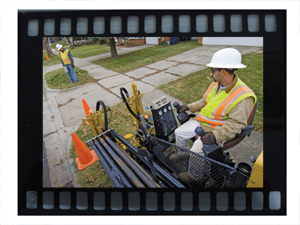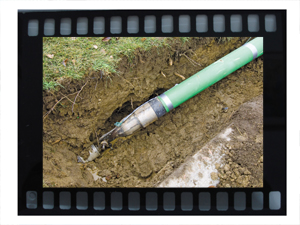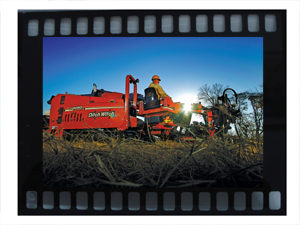The Underground Movement

Under the mainstream methods of backhoeing and excavating a utility counterculture pulsates — pumping life into new markets. Just like the underground counterculture movements, such as the independently published underground press, grew in the 1960s, horizontal directional drilling technology set itself apart from mainstream open cut methods of utility installation with radical new ideas. Thanks to the fiber installation market boom of the late 1990s and early 2000s, trenchless technology like HDD caught on in the mainstream.

While the number of utility-related underground installation jobs has grown significantly over the years, the effects of the current economic downturn are now taking their toll. The abundance of utility and infrastructure projects once on the docket has dwindled. Despite this optimistic predisposition, the realistic side of Ed Savage, trenchless segment manager for Vermeer Corp., in Pella, Iowa, envisions an HDD market that will be flat or down in 2009.
“The overall slowdown of the economy has had a significant impact on a wide array of businesses,” Savage says. “A lot of projects once scheduled for completion in 2009 and beyond have been put on hold. Companies just aren’t spending the money to expand during these uncertain economic times and it appears as if this downward trend is going to be with us for awhile.”
What a Difference a Year Makes
Just a little over a year ago, the HDD underground movement was in full stride. At the beginning of 2008, with perhaps one exception (that being the fiber installation market, which has not experienced a growth period since early 2000), HDD and underground installation markets were strong. Among the most notable was energy. As the price of crude oil reached a historic high and demand for natural gas was on the increase, contractors enjoyed an energy pipeline installation gold rush. Not far behind were water and sewer installations, the result of a heightened awareness that infrastructures were crumbling and inadequate, prompting local governments to appropriate more funds to repair, replace and upgrade dated and failing underground delivery systems.
Just as the boom began within the energy market, so did the decline. As consumers were forced to conserve and drive less due to skyrocketing prices at the pump, demand for gasoline dropped and the price of crude oil plummeted. Despite having realized a period of record profits, energy companies were quick to rein in spending — and among the first to go were pipeline expansion projects.
“With oil and gas pipeline installation projects being driven by the fluctuating price of crude oil and natural gas, expansion projects for both commodities dropped off quickly after prices fell,” Savage says. “This left many contractors looking to replace work that just weeks prior had them scrambling to find qualified drill operators and crews.”
The declining construction and housing market and subsequent banking crisis only compounded the situation. Even for those contractors who found themselves still lucky enough to have sufficient work, banks and lending institutions tightened credit requirements and altered lending practices, which made it difficult to finance new equipment purchases — despite a good credit history.
Not All Doom and Gloom
While industry experts and economic analysts predict a downturn for most construction-related markets in 2009, there’s some good news to report for utility contractors who have joined the underground movement. HDD technology fulfills a growing need for a viable solution for solving America’s underground infrastructure problems. And as a result of the economic stimulus bill recently passed by Congress, water and sewer installation and upgrade projects are readily available. Even some fiber work is out there, although such projects are isolated and more regionally-specific.
“The future isn’t all bleak,” Savage says, “especially for contractors willing to step out of their comfort zone and take on new types of projects. There are a number of opportunities out there. Contractors willing to dedicate the resources necessary to expand their service offerings and the initiative to pursue new markets will be the ones that succeed.”
Savage also cites the increase in the number of long, larger-diameter bores as another opportunity for contractors — most notably for gas pipeline installation projects.
The question, of course, is whether making the capital investment to purchase equipment capable of completing such projects is in a contractor’s best interest. The rewards can be many, but along with the payoff comes a certain degree of risk.
“We [Vermeer] are encouraged by the number of calls we answer in response to inquiries about completing long, larger-diameter bores,” Savage says. “These types of projects present another opportunity for contractors to consider if they are willing to make a long-term commitment to enhance their capabilities and add equipment to their fleet.”
Invest in Your Workforce
Industry experts warn that during challenging economic times there is often a tendency for contractors to neglect some key activities that are fundamental to their long-term success. Among the most important of these is worker training.
Slower work times are ideal for training employees and providing them with the skills they need to operate new underground equipment and learn about new techniques.
Then, when things pick up again, your workforce will be armed with the expertise needed to perform underground jobs that your company would most likely not have pursued because operators lacked the experience. A highly skilled workforce gives you a competitive edge; so when things turn around, your company is in a position to bid projects that broaden the scope of opportunity.
“Well-trained rig operators and a skilled workforce give contractors a competitive edge,” Savage says. “An investment in training pays huge dividends on the jobsite, making businesses more profitable in the long run. Vermeer offers various opportunities for training at both the factory and dealership level.”
Safety programs are also critical. Most project owners require contractors to complete pre-qualification questionnaires before they are even allowed to bid a project. Often the bulk of the questions are safety-related — including everything from a company’s workers compensation experience modification rate (EMR) to the specific content of its safety and health program. What’s more, well-documented safety programs can be a key in retaining insurance coverage. Workers who are well-versed in safety-related issues experience fewer accidents, meaning fewer injuries, and most important, fewer fatalities. Safety-conscious workers are also more productive and tend to take better care of equipment, which is especially important during hard economic times.
Fewer Footprints Underground
The environmental benefits of HDD technology continue to make it an attractive installation option for the many cities and municipalities that are taking aggressive steps to reduce carbon footprint and emissions. Research documents a reduction in CO2 emissions when underground methods are used vs. open cut and this translates to a direct cost benefit for cities that face carbon taxation.

“We continue to be very conscious of the horsepower utilization of our machines,” Savage says. “We have developed hydraulic system designs on the majority of our machines that use less horsepower to deliver the same amount of power. This equates to less fuel use, fewer emissions and reduced carbon footprint.”
Slim Down or Beef Up?
The tumultuous economic climate currently facing the nation is unprecedented. Not since the Great Depression have we experienced anything like this. The key to survival will be different for every contractor. If history is an accurate indicator, the companies most likely to survive will be those most willing to adapt — anxious to explore opportunities outside their comfort zone. Passage of the stimulus bill represents a huge opportunity for contractors, especially those who are used to completing public works projects.
Another important component of success will be to demonstrate value. The mindset that contractors must “do it cheaper” to secure the work is flawed. In reality, this approach lowers the perceived value, not the price, and sets a precedent for project owners as they review and award bids that is unfair to other contractors.
When all is said and done, contractors who have established processes for tackling new types of projects, a well-trained workforce, the resources to invest in new equipment and set long-range objectives will emerge much stronger. For them, this may be a good time to beef up instead of slim down.
Randy Happel is a features writer for Two Rivers Marketing, based in Des Moines, Iowa.
Help Wanted
By Pam Stask, Assistant Editor

“There’s a shortage of experienced workers and people willing to travel in the construction industry,” says Bob Johnston, vice president and division manager of Henkels & McCoy Inc. and president of the Pipe Line Contractors Association (PLCA). “Everyone needs more people with experience.”
Companies looking to expand in size or broaden the scope of services they provide may also face difficulty when looking to add employees capable of doing specific work.
In order to draw in and encourage workers to enter the HDD field, companies are adding incentives and proper training to attract employees. For example, Johnston notes that companies are paying more for an experienced crew. HDD equipment manufacturers such as Vermeer and Ditch Witch even provide training courses for contractors and crews to become accustomed to the machinery a project demands.
“We continue to provide several training events yearly for both end-user customers and our worldwide dealer network, so that they can train the end-user customers,” says Ed Savage, trenchless segment manager for Vermeer Corp.
Richard Levings, Senior Product Manager for trenchless products for Ditch Witch adds: “Our dealers have a very good training program. Most of them have training seminars multiple times a year. If a new crew comes on a new unit, our dealers will go out and spend time training the new crew. We rely heavily on our dealers and that’s why they’re there — to have point-to-point contact and expertise out in the field.”





Comments are closed here.